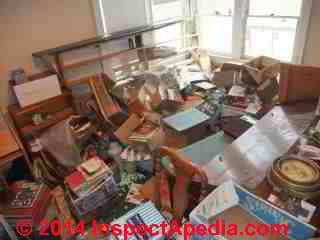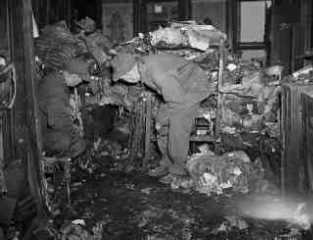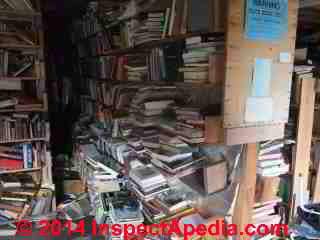 Hoarding Hazards
Hoarding Hazards
Health, Fire, & Safety Hazards from Hoarding Behaviour in Buildings: too much stuff, too many animals
- POST a QUESTION or COMMENT about hoarding behavior hazards in or around buildings.
Building occupant hoarding & hoarding disorder hazards:
This article describes the hazards found in buildings where there has been a history of hoarding, or occupants with hoarding disorder. The hazards associated with hoarding behaviour include immediate fire or other life safety hazards including trips, falls, and fire traps, as well as possible health hazards from animal-induced bacteria, viruses, mold, or other pathogens.
InspectAPedia tolerates no conflicts of interest. We have no relationship with advertisers, products, or services discussed at this website.
- Daniel Friedman, Publisher/Editor/Author - See WHO ARE WE?
Health, Fire & Safety Hazards of Hoarding in Buildings
 Reader Question:
Reader Question:
Just took a took of your website. THANK YOU. Lots of information with facts and logic. I found several areas where animal & pet issues are discussed but I didn't find what I was specifically looking for.
[Click to enlarge any image]
I found the analysis of ammonia but it's mostly work related. I found the info on cleaning up pet smells/waste but it doesn't tell when animal urine/waste/stink becomes a health hazard (and the nature of the hazard(s) from smell/urine/waste) and that is what I was hoping to find.
Any chance of talking someone into writing that article on your website? Excessive collection of "stuff" (aka "hoarding") has also become a hot emotional topic. Any chance of an fact and logic based article on the real hazards (toxins, pest invasion, etc.) and the point(s) where they become health hazards as distinguished from the emotional "too much stuff" that isn't hazardous? - Leslie S., 09/06/2014
Our photo at above left illustrates areas in a home occupied by a book hoarder who amassed over 40,000 volumes. We found fire safety, egress, and serious mold hazards at this property as well as other building hazards that accrued from inability to attend to home maintenance, safety and repair. These book hoarding behavior photographs are examples taken from a different building than the one discussed by the reader's question. - Ed.
Reply: Animal hoarding hazards: urine, feces, and related pathogens as a health hazard
However I expect that a determination of the actual level of health hazards from hoarding as well as for invading animals requires an expert onsite investigation as conditions vary enormously from one case to another.
Our photo (left) illustrates the culprit sitting happily by a large puddle of dog urine in a New Jersey home.
But in more serious cases of animal hoarding (excessive pets in a home: 23 cats & 19 dogs, for example), both biological and often other more immediate fire and safe exit hazards are common.
Since 1947 firefighters and mental health professionals have discussed "Collyer mansions", a reference to a fatal fire in 1947 that burned the mansion owned by the wealthy and accentric Collyer brothers.
The Collyer mansion was jammed with an estimated 120-140 tons of stuff - a condition that blocks emergency exit from a building in event of a fire, feeds the fire, and hampers the efforts of firefighters in both controlling the fire and rescuing building occupants.
In general and in my opinion as well as that of health and other agencies with whom I've worked, hoarding behaviour, depending on its extent, can lead to a variety of very serious hazards of which the most common is a fire hazard accruing from both the storing of large amounts of sometimes combustible materials (newspapers for example) and because often the hoarder ultimately is living in a confined space with limited opportunity for safe exit in the event of a fire.
 The black and white photo at left shows New York City fire officials examining the fatal Collyer brothers fire site in 1947. The photograph was taken by Ed Jackson at the New York Daily News and has been widely published among sets of photographs of the tragic Collyer Brothers hoarding-fire.
The black and white photo at left shows New York City fire officials examining the fatal Collyer brothers fire site in 1947. The photograph was taken by Ed Jackson at the New York Daily News and has been widely published among sets of photographs of the tragic Collyer Brothers hoarding-fire.
Reinisch (2008) gives us some example statistics on animal hoading-related hazards:
Residential home interiors were usually unsanitary, 93%; 70% had fire hazards; and 16% of residences involved in animal hoarding were subsequently condemned as unfit for human habitation. - Reinisch (2008)
That author goes on to point out that
Elderly individuals are at an increased risk for zoonotic diseases due to underlying medical conditions that weaken their immune systems ...
and, addressing your question about the hazards of exposure to ammonia associated with animal hoarding related urine:
There is also a health risk from to ammonia, which at high concentrations causes ocular and respiratory irritation (1,3). The ammonia threshold limit values (TLVs) for a healthy individual should not exceed 25 ppm over an 8-hour period (4).
The TLV is lower if the exposure has exceeded 8 h or if the individual is elderly or has respiratory problems (3). For short-term exposure (15 min), the recommended TLV is 35 ppm (3), while 20 ppm will cause an individual to feel uncomfortable, and 100 ppm will cause irritation of the upper respiratory tract, eyes, and nose (4). There is little information on ammonia levels in animal hoarding cases; however, 1 case reported levels of 152 ppm (5). - Reinisch (2008) & additional citations under Reinisch (see below).
Book Hoarding Hazards: mold contamination, fire hazards, blocked exits, collapsing heavy shelving
You can see examples of those risks in these photographs of a home where the occupant was a book hoarder. The owner, who had died when we inspected this home for his widow, displayed a poster in one of his book rooms, reading "Warning, Rare Book Pox, Highly Contagious, ..."
Health hazards from bacteria, mold, viruses, or other pathogens are surely site and site condition dependent. For example a hoarder who also provides a home to 35 cats, or 12 dogs, or whose home is a haven for mice, rats or other rodents faces still another set of pathogenic risks.
 See ANIMAL or URINE ODOR SOURCE DETECTION where we discuss using a UV light or "black light" to scan building interiors or exteriors for the locations of animal urine and some other contaminants.
See ANIMAL or URINE ODOR SOURCE DETECTION where we discuss using a UV light or "black light" to scan building interiors or exteriors for the locations of animal urine and some other contaminants.
See Barry (2005) for notes on ammonia and health hazards associated with animal hoarding or invasions in buildings.
Gilliam (2011) cites safety hazards associated with hoarding behavior and Schorow (2012) specifically cites hoarding-related fire hazards.
Hoarding Disorder & Pest Invasion
Regarding your question of the relationship between hoarding behaviour and pest hazards, I have not encountered a direct relationship between insect pests and hoarding, though I have found that hoarders are often also unable to attend to basic home maintenance: a condition that means leaks may have gone unattended as well as other building failures (backing up drains, for example).
A result of hoarding disorder may thus include an increased risk of insect attack on the building, rodent invasion, and thus indirectly, even an increase in risk of hanta virus related or other pathogenic-related illnesses, but I cannot substantiate that by research citations. Conicidentally, rodents themselves are hoarders: see Sheikher (1991) in our citations below.
Reader comment:
Thank you for such a wonderful reply. You list the hazards (fire at the top) in the same order I would. I expect it would vary but some objective guidance would be helpful and you've listed sources I'll be reading. However, I also see your first source is Patronek, someone whose research has been entirely funded by animal rights activists, and who has a veterinarian degree and likes to portray himself as a psychologist (an area he seems to have no training in).
I find myself often in debates where I'm in the middle wanting SOME way to analyze and sort fact from fiction. The animal rights activists seem to see any smell in an environment as conclusive evidence of hoarding while the other end of the spectrum things nothing is dangerous. Seems to me the obvious answer lies somewhere between. I look forward to your published results. - L.S. 7 Sept 2014
Reply:
In discussing indoor ammonia exposure hazards, Reinisch (2008) cites the 6th Edition of the Documentation of the Threshold Limit Values and Biological Exposure Indices. ACGIH; Cincinnati, Ohio: 1996. American Conference of Governmental Industrial Hygienists: Ammonia.
It would be relatively easy to make actual ammonia level exposure measurements in a building, and to compare these with ACGIH standards. In my experience there is usually a very wide gap between unpleasant stains or even odors from even well-cared-for household pets such as Rudi the golden retriever in my photograph above, and the very different and egregious animal hoarding cases described by experts one finds in the literature. There would be no rational defense of a claim that Rudi's home showed evidence of animal hoarding nor that Rudi was being treated cruelly.
Regarding your remarks about Patronek VMD, PhD, (Cummings School of Veterinary Medicine at Tufts University) et als, those citations and their funding are commented-on below. It would in my opinion a bit of a stretch and perhaps unjust to equate the supporting trusts cited with more radical and sometimes less than rational activists (e.g. the Animal Liberation Front, sometimes equated at least by search results with "econterorism") suggested by your comment.
Research on Health, Fire & Life Safety Hazards Associated with Hoarding
- Berry, Colin, Gary Patronek, and Randall Lockwood. "Long-term outcomes in animal hoarding cases." Animal L. 11 (2005): 167.
[Note: the research reported by Colin, Patronek and Lockwood is reported by a reader to have been funded by animal rights activists. Gary Patronek is director of the Center for Animals and Public Policy at Tufts University. - Ed.]
Abstract quotation: Animal hoarding is a form of abuse that affects thousands of animals each year, yet little is known about how cases are best resolved, the effectiveness of prosecution, and how sentences relate to the severity of the offense. This lack of information has hampered effective resolution and the prevention of recidivism. This study obtained information about the hoarder, animals, charges, prosecution, sentencing, and recidivism for fifty-six cases identified through media reports. The results showed a disparity between the ways different jurisdictions handled hoarding cases, as well as a lack of communication between agencies. Cases generally lacked follow-up, and it was difficult to determine compliance with court-ordered psychological evaluations and counseling. Additionally, none of the shelters that were ordered to receive restitution has yet received it. Shortcomings in state anti-cruelty statutes contributed to poor outcomes, and current prosecutorial approaches often left officials struggling between the conflicting goals of aggressively prosecuting hoarders and avoiding further institutionalization of the animals. Unfortunately, lenient treatment of hoarders in exchange for immediate custody of the animals appeared to contribute to recidivism. More rapid identification of offenders as hoarders and more creative sentencing involving long-term monitoring could simultaneously speed resolution of cases and avoid extending the suffering of animal victims. - Dong, XinQi, Melissa A. Simon, Laura Mosqueda, and Denis A. Evans. "The prevalence of elder self-neglect in a community-dwelling population: hoarding, hygiene, and environmental hazards." Journal of aging and health (2011): 0898264311425597.
- Frost, Randy O., Gail Steketee, and Lauren Williams. "Hoarding: a community health problem." Health & Social Care in the Community 8, no. 4 (2000): 229-234.
- Gaston, Romina Lopez, Farida Kiran-Imran, Fairooz Hassiem, and John Vaughan. "Hoarding behaviour: building up the ‘R factor’." Advances in psychiatric treatment 15, no. 5 (2009): 344-353.
- Gilliam, Christina M., and David F. Tolin. "Compulsive hoarding." Clinical Obsessive-Compulsive Disorders in Adults and Children (2011): 122.
- Goodman, J. David & Tatiana Schlossberg, "2 Found Dead After Fire at Debris-Filled Home", The New York Times, 24 August 2015, p. A15, Excerpts:
Two people were found dead ... after a fire in a home in Far Rockaway, Queens [NY] that was cluttered with debris, the Fire Department Said. ... Clutter on the first floor hampered both the fighting of the fire and the search for victims ... The Fire Department has long found that debris-filled homes present some of the most dangerous conditions to fire fighters, and the department has gone so far as to try to identify possible locations, known as "Collyers' conditions", [see Ronan 2011 - ed.] after two brothers who died in their Harlem home amid piles of hoarded belongings in 1947. - Hoarding of Animals Research Consortium. "Health implications of animal hoarding." Health & Social Work 27, no. 2 (2002): 125-136.
- Kim, Hyo-Jin, Gail Steketee, and Randy O. Frost. "Hoarding by elderly people." Health & Social Work 26, no. 3 (2001): 176-184.
- Lidz, Franz, Ghosty Men: The Strange but True Story of the Collyer Brothers and My Uncle Arthur, New York's Greatest Hoarders (An Urban Historical), Bloomsbury USA (2003), ISBN-10: 158234311X
ISBN-13: 978-1582343112, Excerpting from Amazon.com's book review quoting Publishers Weekly
... 65-year-old Homer Collyer, blind and crippled by rheumatism, was found dead in his dilapidated, junk-filled Harlem brownstone in March 1947... Langley, whose body was finally located under piles of debris. ... The compulsive hermits came from a respected, well-to-do family and were educated at Columbia, Homer as a lawyer and Langley, who was a talented pianist, as an engineer.
They became part of New York lore in August 1938, when the World-Telegram wrote about the pair and their once-fashionable house on Fifth Avenue and 128th Street, which was crammed full of pianos, other instruments, bicycles, chandeliers, clocks and thousands of newspapers, "strewn in yellowing drifts across the floor." - Lucini, Gregory. "An analysis of fire incidents involving hoarding households." PhD diss., Worcester Polytechnic Institute, 2009.
- Patronek, Gary J., Lynn Loar, Jane N. Nathanson, "Animal Hoarding: Structuring interdisciplinary resonses to help people, animals and communities at risk",[PDF] - retrieved 27 Aug 2015 original source http://vet.tufts.edu/wp-content/uploads/AngellReport.pdf
Overview Excerpt: Animal hoarding is an important, misunderstood, and under-recognized community problem that affects both human and animal welfare. It is responsible for substantial animal suffering and property damage. Often associated with adult self-neglect, animal hoarding can also place children, elders, and dependent adults at serious risk and can be an economic burden to taxpayers. ...
Since its formation, HARC has published papers on animal hoarding in the peer-reviewed literature, written several sets of guidelines for intervention and case management, developed a web site for the public as well as human health professionals and animal welfare agencies (http://www.tufts.edu/vet/cfa/hoarding)
[Funding for this project was provided, in part, by the Edith Goode Residuary Trust (established to meet sheltering objectives for animal welfare), The Massachusetts Society for the Prevention of Cruelty to Animals (MSPCA) contributed logistical support for the meeting. The work of HARC has previously been supported by the Kenneth A. Scott Charitable Trust (a private foundation focused on preventing cruelty to animals and promoting the humane treatment of animals, particularly companion animals such as dogs and cats, and other species of animals commonly kept as household pets) ] - Reinisch, Amanda I. "Understanding the human aspects of animal hoarding." The Canadian Veterinary Journal 49, no. 12 (2008): 1211. Reinisch also cites:
- 1. Frost RO, Steketee G, Williams L. Hoarding: A community health problem. Health Soc Care Comm. 2000;8:229–234.
- 2. Kuehn BM. Animal hoarding: A public health problem veterinarians can take the lead in solving. J Am Vet Med Assoc. 2002;221:1087–1089.
- 3. Patronek G. Hoarding of animals: An under recognized public health problem in a 148 difficult to study population. Pub Health Rep. 1999;114:81–87.
- 4. 6th Edition of the Documentation of the Threshold Limit Values and Biological Exposure Indices. ACGIH; Cincinnati, Ohio: 1996. American Conference of Governmental Industrial Hygienists: Ammonia
- 5. Arluke A, Frost R, Luke C, et al. Health implications of animal hoarding. Health Soc Work. 2002;27:125–132.
- 6. Patronek GJ, Loar L, Nathanson JN, editors. Animal hoarding: Structuring interdisciplinary responses to help people, animals and communities at risk. Hoarding of Animals Research Consortium; Boston, Massachusetts: 2006.
- 7. Dinning LB. No room to spare: Ottawa’s community response to hoarding plan. 2006. [Last accessed October 15, 2008]. [manuscript on the Internet] Available from: http://www.cmhahp.on.ca/documents/SCPI_FINAL_Report_No_Room_to_Spare.pdf
- 8. Beeler E. Earlier intervention needed in animal-hoarding cases. J Am Vet Med Assoc. 2003;222:1674.
- 9. Chapin R, McKenzie S, Landry S, Reynolds K, Rachlin R, Koenig T. Community tenure of older adults who hoard: Identifying risks and enhancing opportunities. University of Kansas School of Social Welfare; 2007. [Last accessed October 15, 2008]. [monograph on the Internet] Available from: http://www.oaltc.ku.edu/Reports/Final%20Report%20053107.pdf
- 10. Berry C, Patronek G, Lockwood R. Long-term outcomes in animal hoarding cases. Animal Law. 2005;11(167):167–194
- 11. Arluke A, Frost R, Steketee G, Patronek G, Luke C, Messner E, Nathanson J, Papazian M. Press reports of animal hoarding. Soc Anim. 2002;10:1–23
- 12. Frost R. People who hoard animals. Psychiatric Times. 2000;17(4
- 13. Lockwood R. The psychology of animal collectors. Trends. 1994;9:18–21.
- [The original article includes additional citations - Ed]
- Ronan, Keith P. "Navigating the Goat Paths: Compulsive Hoarding, or Collyer Brothers Syndrome, and the Legal Reality of Clutter." Rutgers L. Rev. 64 (2011): 235.
- Schorow, Stephanie. "The dangers of too much stuff." NFPA Journal 106, no. 1 (2012): 44-52. - [PDF] retrieved 25 Aug 2015, original source: http://www.decluttercoach.ca/wp-content/uploads/2012/09/The_Dangers_of_Too_Much_Stuff.pdf
- Sheikher, C., and S. D. Jain. "Damage and hoarding by rodents and their control in standing wheat in Himachal Pradesh." International Journal of Pest Management 37, no. 3 (1991): 298-300.
- Steketee, Gail, and Randy Frost. "Compulsive hoarding: current status of the research." Clinical Psychology Review 23, no. 7 (2003): 905-927.
- Turner, Kathy, Gail Steketee, and Laura Nauth. "Treating elders with compulsive hoarding: A pilot program." Cognitive and Behavioral Practice 17, no. 4 (2010): 449-457.
- Weiss, Kenneth J. "Hoarding, hermitage, and the law: why we love the Collyer brothers." Journal of the American Academy of Psychiatry and the Law Online 38, no. 2 (2010): 251-257.
Abstract:
Interest in hoarding behavior has intensified, as it works its way through DSM-V deliberations and treatment models. Meanwhile, both documentarians and fiction writers have embraced accounts of individuals with disposophobia and romanticized versions of the Collyer brothers, the Hermits of Harlem.
In this article, I examine the range of media and professional attention given to hoarders and their problems and then focus on a potential role for forensic mental health professionals. The psycholegal problems of hoarders include health and zoning code violations that evolve into criminal charges, civil commitment, questions of animal cruelty, landlord-tenant disputes, divorce and custody evaluations, testamentary capacity, and child-neglect charges. - Erskine, Helen Worden, Out of This World - A Collection of Hermits & Recluses Their Ways of Life & the Stories Behind Their Retreats. Collyer Brothers, Mary E. Wood, Mary & William Colgate Colby , Leary Sisters, Baby Doe Tabor, Hetty Green, Emily Thorn ETC, Putnam, Collyers Bros. (1953)
...
Continue reading at STAIR FALL & TRIP HAZARDS or select a topic from the closely-related articles below, or see the complete ARTICLE INDEX.
Or see these
Recommended Articles
- ACCESSIBLE DESIGN
- ELDERLY & VETERANS HOME SAFETY
- NEST CAM INSTALLATION & USE - respectful use of a Nest cam® or Dropcam® or similar home security system may be helpful in some senior residences.
Suggested citation for this web page
HOARDING HAZARDS at InspectApedia.com - online encyclopedia of building & environmental inspection, testing, diagnosis, repair, & problem prevention advice.
Or see this
INDEX to RELATED ARTICLES: ARTICLE INDEX to BUILDING SAFETY
Or use the SEARCH BOX found below to Ask a Question or Search InspectApedia
Ask a Question or Search InspectApedia
Try the search box just below, or if you prefer, post a question or comment in the Comments box below and we will respond promptly.
Search the InspectApedia website
Note: appearance of your Comment below may be delayed: if your comment contains an image, photograph, web link, or text that looks to the software as if it might be a web link, your posting will appear after it has been approved by a moderator. Apologies for the delay.
Only one image can be added per comment but you can post as many comments, and therefore images, as you like.
You will not receive a notification when a response to your question has been posted.
Please bookmark this page to make it easy for you to check back for our response.
IF above you see "Comment Form is loading comments..." then COMMENT BOX - countable.ca / bawkbox.com IS NOT WORKING.
In any case you are welcome to send an email directly to us at InspectApedia.com at editor@inspectApedia.com
We'll reply to you directly. Please help us help you by noting, in your email, the URL of the InspectApedia page where you wanted to comment.
Citations & References
In addition to any citations in the article above, a full list is available on request.
- Wikipedia, "Collyer Brothers", retrieved 27 August 2015, original source: https://en.wikipedia.org/wiki/Collyer_brothers
Excerpt: Homer Lusk Collyer (November 6, 1881 – March 21, 1947) and Langley Wakeman Collyer (October 3, 1885 – c. March 9, 1947), known as the Collyer brothers, were two American brothers who became infamous for their bizarre natures and compulsive hoarding. For decades, the two lived in seclusion in their Harlem brownstone at 2078 Fifth Avenue (at the corner of 128th Street) where they obsessively collected books, furniture, musical instruments, and myriad other items, with booby traps set up in corridors and doorways to ensnare intruders. In March 1947, both were found dead in their home surrounded by over 140 tons of collected items that they had amassed over several decades. - In addition to citations & references found in this article, see the research citations given at the end of the related articles found at our suggested
CONTINUE READING or RECOMMENDED ARTICLES.
- Carson, Dunlop & Associates Ltd., 120 Carlton Street Suite 407, Toronto ON M5A 4K2. Tel: (416) 964-9415 1-800-268-7070 Email: info@carsondunlop.com. Alan Carson is a past president of ASHI, the American Society of Home Inspectors.
Thanks to Alan Carson and Bob Dunlop, for permission for InspectAPedia to use text excerpts from The HOME REFERENCE BOOK - the Encyclopedia of Homes and to use illustrations from The ILLUSTRATED HOME .
Carson Dunlop Associates provides extensive home inspection education and report writing material. In gratitude we provide links to tsome Carson Dunlop Associates products and services.




